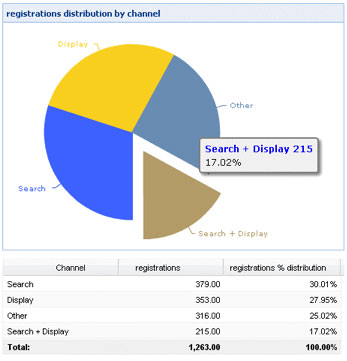 “Displaying Search” is a column capturing the intersection of display advertising and search marketing.
“Displaying Search” is a column capturing the intersection of display advertising and search marketing.
Today’s column is written by Suman Basetty, Director of Product Management at Efficient Frontier, an online performance marketing company.
Sophisticated online marketers want to know how their display and search ad spend are influencing each other, their conversion rates and, most importantly, understand how to distribute their ad spend across these channels to maximize returns. In order to answer these questions, marketers need two things:
- A centralized tracking system across both search and display.
- The ability to apply the right attribution model and optimize across both channels.
Tracking systems like Atlas and DART to some extent tried to solve the first problem. However, in order to solve the second issue, marketers need the ability to bid their display ads up or down (in conjunction with their search ads) based on how the ads are directly and indirectly affecting the conversions.
With the recent surge of display inventory becoming available in biddable form (at impression level in many cases) optimization across search and display can now happen.
The graph below shows an example of distribution of registrations to an advertiser’s website from multiple channels and illustrating the number of registrations with prior search and display ad interactions.

A significant challenge arises in organizational and reporting structures at companies. Many marketing teams continue to have display and search teams working separately and often use different tracking and optimization systems. As a result, conversions with overlapping events (for example, a search click preceded by a display click) are typically double counted. That is, each channel (search and display) will independently take credit for such conversions. Lacking the visibility into how each advertising channel is influencing the other, advertiers over-estimate advertising efficacy and may over-pay for placements and terms. Let’s examine a site retargeting scenario to illustrate the challenge.
When you are retargeting visitors to an advertiser’s site, you are inevitably reaching visitors that came to the site through paid search clicks. This means users who have come through paid search clicks and then viewed a retargeted display ad and then converted will be double counted if the advertiser is not using the same tracking systems across these channels or not using the right attribution model.
We typically see that 30-40% of all conversions arriving from a display impression, or click, are preceded with a paid search click. This overlap is significant enough that marketers need to pay close attention to attribution. However, double counting conversions is just one problem. The other issue is that advertisers are not getting the proper visibility into how one advertising channel is influencing the other.
In our campaigns, we have seen that up to 10-15% of conversions that had a prior display impression had the last event as a paid search click. When we looked further into the path to conversion data, it is interesting to see that many of these users see multiple banner ads and, within minutes of seeing the last banner ad, visited their favorite search engine, searched and then clicked on a paid listing prior to conversion. Clearly display influenced the search, although that ad will rarely be given credit. Looking at the issue in reverse, we see that 20-30% of conversions that had a prior display impression or click had a paid search click prior to the display event. In essence, this 20-30% overlap consists of users that came to the advertiser’s site through a paid search click and then saw a re-targeted banner ad prior to converting.
AdExchanger Daily
Get our editors’ roundup delivered to your inbox every weekday.
Daily Roundup
What this data shows is that there can be significant cross channel influence between search and display. The key for advertisers is to have both a centralized tracking system to ensure they can obtain cross channel insights and an optimization platform that can activate this data in display and search buying. Only with centralized tracking can different conversion attribution models be tested, making cross channel optimization possible.
As more and more biddable display becomes available new DSPs seem to be launching on a weekly basis with their own unique offering (or spin). However, almost all of these DSPs are focusing on managing and optimizing display campaigns independently of search. We believe biddable display provides a bigger opportunity when managed and optimized across both search and display, making the overall online marketing spend much more efficient.
Follow Efficient Frontier (@efrontier) and AdExchanger.com (@adexchanger) on Twitter.












